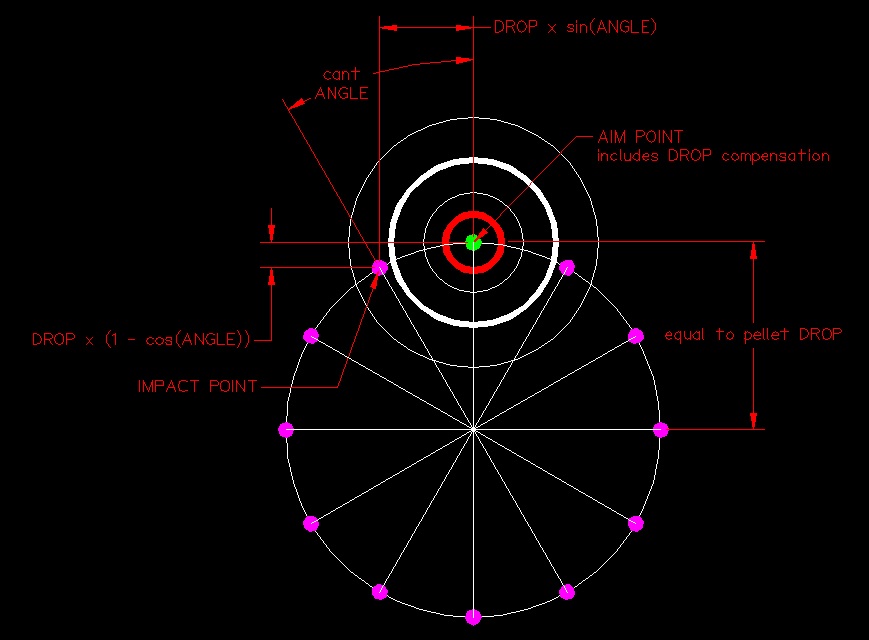I'm searching all over the internet"GQ" Look in UK , France or Germany.
Upvote 0
I'm searching all over the internet"GQ" Look in UK , France or Germany.
Thank you to both of you guys."broekzwans"
"Scotchmo"@broekzwans,
When you cant the gun, while holding on target:
The bore line (dashed cyan line) is not the cant axis. NO
The parallel lines of the scope above the bore (dashed orange and green lines) are not the cant axis. NO
The cant axis is the line of sight to the center of the target (solid orange and green lines). YES
(trajectory compressed in x-axis to fit screen):
I already see where our stories are mismatching. We're both right, we're just looking at it a different way. Maybe I had to write this clearer but the dots I've used in the calculation above are the start of the line of sight and the placement of the bore at that amount of cant. With the angling plots I'm looking at the tip of the muzzle towards the target.
Your story holds if the canting axis is right in between the two scopes, in that case the scope height doesn't matter and will give the same spread from canting. If we move the first scope to 1 cm and the second scope to 11 cm there is still no change. You're completely right in this!
If we look at three different swiveling points I think it'll be clear. In the following I've added an extra dot, a red one, this will depict the center between the two scopes.
The first situation: center of my canting axis is the line of sight from the 10 cm scope
The second situation: the center of my cant axis is the center between the two scopes
For the record: added the 1 cm and 11 cm scope height into the picture for extra clarity
The third situation: The center of my cant is the line of sight from the 2cm scope
As you can see above, when we chose the center of the scopes as canting axis both scopes move an equal amount from the bore which causes no impact shift between the two scopes. If we look at the total displacement of the bore compared to the cant axis you can see that the horizontal barrel misalignment becomes larger with an increasing scope height.
For the record: I'm not trying to burn you or trying to be a smart ass, I'm just trying to get us on the same page








Edit: szottesfold and broekwans are correct for some specific instances when using aim points other than the bullseye as a means of drop compensation. Ignore what I said below."broekzwans"...
But watch out, this phenomena only holds for shooting on the distance where you’ve zeroed your rifle. For further distances with the initial zero at the same point a higher scope will have worse effects of cant and for distances closer than the initial zero a higher scope is beneficial. For more information it is beneficial to read this article: http://www.szottesfold.co.uk/2012/03/high-scope-and-canting-end-of-ancient.html...
I never liked that type of scope level. I used one once, and there was no way to adjust it. If they end up in line with the scope-bore, you got lucky. I use levels that are mounted to a ring on the scope that can be rotated to achieve alignment."broekzwans"The problem I had with the hawke bubble level is that it's made for 9-11 mm and my rail is 11 mm. If you use them on an 11 mm rail they will start to climb upwards when tightening. Therefore I don't use them anymore..
"GQ"Mine US Optics swivel end up 100% with my FX Impact bore.
So I got lucky.
You can get one from Canada."broekzwans"
"GQ"Mine US Optics swivel end up 100% with my FX Impact bore.
So I got lucky.
I believe the US Optics are a better product than the hawkesthat's one of the reasons I was looking for the US optics bubble level but I guess it's sold out everywhere and if I recall correctly I've read somewhere that the next shipment will be around september somewhere
GoodtogoHere is what I got out of this discussion! @broekzwans has the coolest looking bipod I have ever see. Could we have the brand name for it?